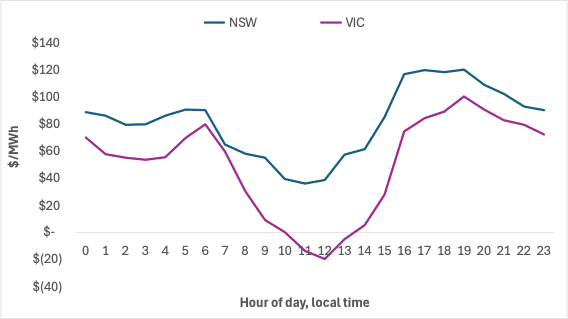In an excellent post last week, Renew Economy editor Giles Parkinson took issue with having been forced onto expensive time-of-use tariffs after a half-hourly interval (“smart”) meter was installed at his house.
He makes many pointed remarks about policy and regulatory failure. The article elicited 95 comments (when I last looked), many of which struck me as very well informed and insightful.
Giles lives in regional NSW (in the Essential Energy distribution area). I live in Victoria (in the Jemena distribution area). I have been delighted with my retail prices (to the point that I wrote about it recently).
Remarkably just a month or two after that article, my retailer introduced a deal for EV owners, that was even better. So, I have come know the retail market, in my personal experience at least, as responsive and thoroughly customer focussed.
Giles, however, writes of something quite the contrary – to deep resonance with his readers – and so I thought I might spend a few hours digging a little deeper at the differences between Giles’ experience and my own.
The Time of Use retail prices that were forced on Giles (before being withdrawn and he was put back on the pre-existing flat tariff of 37c/kWh) are summarised below. (All rates in cents per kWh unless otherwise indicated).

My retail prices are summarised below:

Let’s compare these. Both Giles and I have EVs and rooftop solar and roughly comparable monthly consumption and feed-in electricity into the grid from our rooftop PV.
My retail offer (from my retailer OVO) is specifically for EV owners. I pay nothing to charge my EV (or indeed for any other electricity consumption) between 11am and 2pm, and I pay 8 cents per kWh for consumption from 12pm to 6am, and I get 8 cents per kWh for the surplus PV production that I feed in to the grid.
My most expensive rate is about 10% dearer than the cheapest rate forced on Giles, but his feed-in rate is slightly better than mine. My retail offer provides powerful incentives to reduce export and increase consumption at the time of the solar peak period and in the wee hours of the morning.
It is well aligned to the time profile of VIC wholesale (spot) prices (see chart below). By contrast the ToU tariffs forced on Giles is poorly aligned to the time profile of NSW spot prices.
The overall average price in my last three bills has been 18 cents per kWh. Giles did not have half-hourly consumption data readily available for me to look at when I wrote this, but based on his likely profile and knowledge of his consumption I would estimate that his overall average price is at least double and possibly triple mine.
I am perfectly happy with all aspects of metering, billing and customer service and so my apparently cheap deal is not being paid for in some other way. Giles, however, is evidently is not happy with metering, billing or customer service so his premium rates are coming on top of poor service. (Editor’s note: True).
Can such different outcomes be explained by differences in the cost of producing electricity in NSW and Victoria ? The chart below shows the median of the 3,180 five-minute prices during each hour of the 24 hour day, during 2024.
Measured this way, VIC prices are always lower than NSW prices, and they are negative from 10.30am to 1.30pm. But the gap between NSW and VIC prices are no-where near the huge gap between Giles’ and my retail prices, so these wholesale price differences can’t meaningfully explain the retail price differences.

What about network charges, can this explain the difference? The tables below (all rates cents per kWh unless otherwise indicated) provide data on the network tariff rates in the two regions.
| Peak (5pm to 8pm (weekdays)) | Shoulder (7am to 5pm) and (8pm to 10pm) weekdays | Off-peak (10pm to 7am weekdays) and 10pm Friday night to 7am Monday morning | Daily charge ($/day) | |
| Giles (Essential Energy) | 17.7676 | 13.8149 | 5.4028 | 1.278 |
| Peak (3pm to 9pm) | Off-peak (9pm to 3pm) | Daily charge ($/day) | |
| Me (Jemena) | 17.36 | 4.886 | 1.16 |
At first sight (peak and off-peak rates and daily charges) are quite similar, on closer inspection they are quite different and network tariff differences have quite some explaining to do.
Specifically, Essential Energy’s peak rates apply for 1,095 hours per year and its shoulder rates (not much lower) apply for 3,128 hours, and off-peak for the remaining 4,537 hours.
By contrast Jemena’s peak rates apply for 2,190 hours but all the rest (6,570 hours) is much much cheaper off-peak. Jemena’s typical average charge will therefore be much lower than Essential’s.
What about differences in my and Giles’ interest and ability to engage in the retail market? Despite his prodigious interest in electricity markets, in his article Giles makes clear his disinterest in the hard yards of engaging in the retail market for his own home.
I checked his rates and the deal that Origin Energy had him on is about 10% better than their Basic Offer so he is not on Origin’s worst deal. But had he known about it, he could however have accessed a deal similar to one that I am on that provides electricity for 8 cents per kWh from 12am to 6am and for zero cents per kWh from 11am to 2pm. This would probably have halved his bill.
But he would not have found out about this deal through the Australian Energy Regulator’s price comparison website because it does not ferret out EV-specific deals. And on top of that, even though the AER’s price comparison site knows of OVO’s offer, it fails to correctly describe the offer and the rates that apply at different times of the day.
(As an aside, the Victorian Government’s price comparison website has done no better – it too fails to identify deals available to EV owners and would not have pointed me to the deal I am on – which is a far better deal than the deals it says are best for me.)
So who to blame here: Giles for not having obtained sufficient mastery of the retail market; or continued failure (two decades after retail market deregulation !!!) of the tricky business of price comparison?
You take your pick. Whichever you choose, a failure to find close to the best deal (“search costs” in economists’ jargon) also seems to be an important factor here.
Is there some bigger picture that underlies these problems? I am sorely tempted to make some sweeping generalisations about the awareness of our energy bureaucracies (and often also ministers) of Adam Smith’s dictum that the sole purpose of production is consumption.
I will resist the urge to scratch that itch. But indulge me just this one: the NSW energy bureaucracy seem to have long led the pack in the depth of their disregard for Smith’s dictum.
At the end of his article, Giles indicates his response to his discovery of how badly he is being fleeced (amusingly many who commented on his article expressed surprised at his ingenué) is to install the biggest battery he could afford to escape the shared grid as best he can.
It is remarkable that in yesterday’s Financial Review, the recently retired Chairman of the Australian Competition and Consumer Commission, Rod Sims, has much the same advice for those seeking to live the energy-intensive green exports dream. A bit of an indictment, no?
Editor’s note: Yes, I was caught by surprise by the bill. I would point out that it changed after we had signed a contract to sell our house, and since putting the house on the market some six months earlier our attention had been elsewhere – finding a new place to live! But I never imagined I would get fleeced this badly.







